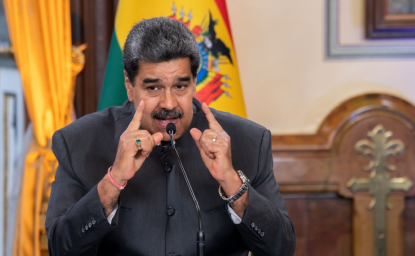The COVID-19 pandemic and war in Ukraine provide daily reminders of how global market instability hurts local communities. By disrupting trade relationships around the world, these events contributed to empty store shelves, energy crises, and inflation. In response, calls for trade reform have grown louder as countries scramble to diversify supply chains and to reshore vital industries.
However, the lesson from recent history is not that trade is harmful. Rather, the problem is trade volatility. Trade shocks are what punish firms, hurt workers, and reduce economic security. For those reasons, the conversation about reforming trade must focus on ways to promote a more stable marketplace.
Why Volatility Matters
Economists have recognized trade volatility’s dangers for decades. Unexpected trade shocks—to imports or exports—can harm all levels of the market. For countries, volatility drives up government budget deficits, amplifies business cycles, and deters inward investment. Sustained volatility can be so toxic that it reduces long-term growth.
All those “macro” effects matter for workers. Firms in traded industries rely on predictability to make business decisions. Yet, market shocks complicate economic planning. If a carmaker or civil aircraft manufacturer cannot know the price of steel tomorrow, they cannot know how many workers to hire today—or what to pay them.
The US labor force experienced volatility’s impact firsthand in the decade between the Great Recession and the pandemic. From 2010 through 2019, total manufacturing employment grew by 11.5 percent. However, in industries exposed to greater volatility, job growth was only 5 percent. Wages in volatile industries were equally sluggish, growing 2 points slower than the national average.
Countries like the US do not have it as bad as smaller, poorer markets. Despite heavy reliance on China, the US is somewhat insulated from shocks because it has one of the world’s most diversified trade portfolios. Developing economies are not so lucky. Many poorer, smaller markets rely heavily on raw materials and commodities exports. These industries are notoriously volatile, and shocks to them have a larger negative impact on economic welfare in low- and middle-income countries.
As a result, volatility is an issue in which countries around the world should have a shared interest. And, if we care about promoting development and alleviating poverty, then we should make market stability a core policy goal.
Origins of Volatility
Some market shocks are impossible to prevent, such as a flood that disrupts agricultural production. However, political unrest and war also contribute to instability. Seemingly isolated domestic conflicts can generate instability that radiates outward through the marketplace to business partners around the world.
These disruptions are not the norm.
The most common cause of trade volatility is policy volatility. For example, when countries introduce new protectionist barriers, they disrupt trade relations in ways that may generate more volatility, not less.
Consider tariffs, which governments often impose specifically to insulate a domestic producer from a costly trade shock. That protected industry may benefit, but the trouble is that tariffs can have three additional effects. First, tariffs cause a disruption for the exporter who now incurs an added cost for doing business. Second, and related, tariffs can cause trade diversion, exposing “bystander” markets to a sharp increase in additional imports. Third, and perhaps most importantly, tariffs expose other industries in the protected market to retaliation.
Thus, trade barriers do not reduce aggregate volatility—they simply shift it to other parts of the marketplace.
Identifying the Problem
The costs associated with tariffs do not dictate that countries should open their economies entirely. There are valid reasons to limit trade on the grounds of national security, public health, and the environment, among other important considerations. However, to the extent possible, formal, mutually agreed upon rules should govern those policy decisions.
This remains the crucial role of international trade law. Trade treaties, which received so much criticism in recent years—both in the US and abroad—are not just about trade promotion. They are about trade stabilization. They are about taking the global economy out of an economic Wild West and putting it into a rules-based setting.
Trade treaties reduce volatility in a couple of ways. Not least, treaties reduce the likelihood that member governments introduce new instability sparking barriers against one other. Locking in a cooperative relationship, in which countries commit to less protectionism, is one of the key motives behind trade agreement formation in the first place.
Naturally, governments still face incentives to protect their economies when shocks do occur. That is why all modern trade agreements offer opportunities for legally permissible escape. Flexibility provisions, like anti-dumping and safeguards, allow countries to relax their trade-liberalizing commitments in a controlled, predictable fashion. World Trade Organization rules specify when and where countries can use escape clauses legitimately. The rules also specify the size and duration of the measures countries may use. The point is that flexibility is not a blank check for protection. It is a legal, mutually agreed upon system allowing the trading system to bend without breaking.
Of course, the World Trade Organization’s history shows that simply having rules does not guarantee compliance. Governments regularly accuse one another of trade discrimination, including abuses of escape clauses. That is why trade deals build in formal mechanisms for dispute settlement. Countries can sue their trade partners when they believe discrimination has occurred. The idea is that imposing some cost for violating the rules—including the authorization of trade retaliation—should reduce the likelihood that disruptive policy changes occur in the first place.
Taken in sum, then, trade law can help constrain the kinds of policies that disrupt the market and leave countries, their firms, and their workers worse off due to instability.
Finding the Solution
None of this is to say that trade law is perfect in its current form. Many trade deals remain silent about contemporary concerns regarding climate change, e-commerce, and crypto trading. For those reasons alone, reform is long overdue. But reform does not mean shredding the rules. It means reinvesting in a system that promotes sustainable, lasting trade cooperation. Rules that address volatility have to be central to that conversation.
At the same time, many of those arguing for reform recognize that trade rules cannot address all of globalization’s problems. Volatility will never disappear entirely from the marketplace, and countries need domestic policy solutions to address free trade’s uneven impact on local communities. But, while social safety nets at home might help extinguish the fires volatility lights, effective trade rules can prevent the match from ever being struck.
Author

Associate Professor in the School of Government and Public Policy and the James E. Rogers College of Law, University of Arizona

Wahba Institute for Strategic Competition
The Wahba Institute for Strategic Competition works to shape conversations and inspire meaningful action to strengthen technology, trade, infrastructure, and energy as part of American economic and global leadership that benefits the nation and the world. Read more

Explore More
Browse Insights & Analysis
360° View of How Southeast Asia Can Attract More FDI in Chips and AI



